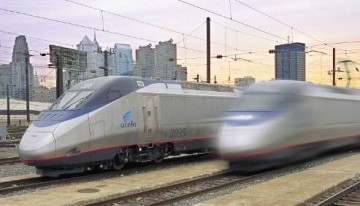
MonTREAL – The British government unveiled an ambitious plan Monday to develop high-speed rail lines linking London to cities in northern England, but railcar manufacturer Bombardier is first focused on a large opportunity in the United States.
Amtrak, in conjunction with the California High-Speed Rail Authority, recently issued a request for information due Feb. 7 for next generation high-speed rail cars to operate on Amtrak’s Northeast Corridor and on California’s developing rail corridor.
Amtrak hopes to buy up to 12 new train sets to supplement its Bombardier-built Acela line, and then replac the 20 current train sets in early 2020. California is initially looking to order 27 train sets able to travel up to 367 km/h.
“We are very much interested in this procurement and pleased to see Amtrak and California come together on it,” said Bombardier Transportation spokeswoman Maryanne Roberts.
Working together creates efficiencies and large procurement projects like this are good for the industry because it stimulates investment in American facilities, she added in an email.
At this point, interested railcar builders need to express their interest and summarize their experience in building trains that can travel over 250 km/h and which have been in commercial operation for at least two years.
A request for proposals could be issued by September, with an order placed in 2014. Details about when a contract will be awarded and delivery schedules isn’t yet known.
While the U.K. decision to begin the second phase of its high-speed rail network is positive, work will initially be focused on selecing preferred routes.
“The project in the U.K. could be an opportunity for us but it is so far away that we don’t know yet what technology will be required and how many train sets will be purchase,” she noted.
Still, Bombardier is expected to be among the global bidders that will likely include Alstom and Siemens, along with Chinese and Japanese manufacturers.
David Tyerman of Canaccord Genuity said it’s too early to say which company has the edge.
“I think a lot of people would have thought before that Bombardier would have had an advantage over everybody else because they have that really large operation in Derby but that didn’t stop Siemens from winning Thameslink,” he said in an interview.
Ultimately, he said the winning bid will come down to value, especially since the railway will likely involve some sort of private-sector involvement.
“Obviously, I imagine it would be a good contract just given the distance involved, there would be a lot of train sets involved so I’m sure that they will bid aggressively and there’s got to be some assistance to have a large local operation.”
Tyerman said he’s a bit surprised that the cash-strapped British government would proceed with such a large project, one which still faces big hurdles to overcome.
“It appears that many government are using infrastructure spending as a way to try and jolt their economies in a positive direction so that might play a role in all of this.”
In addition to financial concerns, local residents are worried that the seleced routes will become a blight on the picturesque countryside.
The British trains would travel up to 360 km/h, reducing the travel time between London to Manchester nearly in half to one hour and eight minutes. Phase one would reduce travel between London and Birmingham to 49 minutes, from the current one hour and 24 minutes.
The first section of the line is due to be completed by 2026 and the second by 2032.




